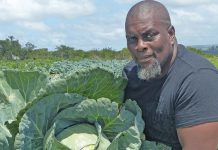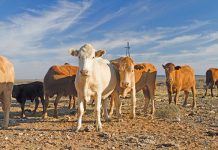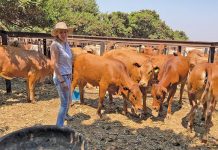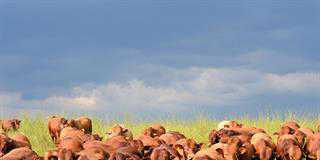
When Simeon and Jarren Hurwitz took over their grandfather, Dr Barney Hurwitz’s, farming business near Davel in Mpumalanga six years ago, they saw it as an ideal opportunity to establish a profitable stud beef enterprise. And the fact that they were both accountants working in Sandton did not deter them.
Dr Hurwitz started importing Boran cattle from Zambia in 1995. At the time, South African farmers were importing this breed from Kenya. He established a Boran herd through embryo and semen transfer years before a Boran Society was established in this country.
When Simeon and Jarren took over Hurwitz Farming, however, there were only about 30 animals. The brothers realised that the only way to make sound business decisions was to educate themselves about the breed, and in 2010 they started attending auctions.
A desirable breed
“The prices attracted the entrepreneur in me,” Simeon recalls. “Borans sold for between R50 000 and R70 000, with other cattle selling for far less. I bought one appendix B heifer at the time,” he says. In 2011, the prices increased radically and Simeon bought the cow Julia B 03 17 and her calf for R200 000 at the Boran National Sale. Today, the brothers have the largest Boran stud in South Africa with over 1 000 animals.
The brothers practise embryo flushing and transfer. The 500 cows in the brothers’ commercial herd primarily serve as embryo recipients and surrogates for the Boran stud breeding programme. They are also used as replacement heifers and commercial weaner production.
“We chose to invest in Boran for two reasons,” explains Simeon. “Firstly, because our grandfather was a pioneer importer of the breed. Secondly, for the economic benefit. Boran are highly tick-resistant and some farmers do not even dip them. They’re also tougher than most other breeds and very adaptable, while also requiring very little maintenance.”
Simeon says they only fully realised the benefits of the breed when they got the stud off the ground. “There’s an intelligence factor in their behaviour. They don’t jump fences and they walk easily in hand. They also have an inherent survival instinct. When a cow loses a calf she calls for it for a day before she moves on.
“While other breeds are phenotypically identical, the Boran is physically unique and there is no stereotypical colour. Some become so tame you can develop a pet-type relationship with them.” Simeon admits that in the early days he and Jarren bit off more than they could chew.
“We bought registered Santa Gertrudis, Manso Brahman, Simbra and Simmentaler cows and flushed embryos from all of them. Now we know that we can’t have many different studs. Agriculture moves at a slower pace than life in Johannesburg. And we now know our limitations.”
Working together
Initially, Simeon and Jarren did not allocate their respective farming responsibilities according to their interests; each brother simply tackled different issues as they arose. These days, however, Simeon is responsible for the cattle and stud operation, while Jarren is in charge of the crops and feedlot. They find working together easy.

From left: Hendy Mathews (CEO, who manages the enterprise), Simeon Hurwitz and Jarren Hurwitz.
The brothers are hands-on, visiting the farm once a week for two or three days at a time. The operation is fully integrated, with managers and systems working together towards a common goal. This applies to every aspect, from the siring of the weaners, to the operation of the feedlot, to the business’ butcheries.
Thinking like accountants
Simeon admits that he did not initially see himself as a stockman and that the past six years have been the steepest learning curve he has ever experienced. The brothers’ accounting background means they are more conservative than most about their business practices and they always aim to see the bigger picture.
“We try to calculate risks and use a cost and financial accounting approach,” says Simeon. “Our stock is multifaceted and feedlot stock is tied up for months.” Simeon offers these tips to prospective stud breeders: “Find the best breed for your pocket and environment, with low maintenance needs, otherwise the input cost will cripple you.
“Be strict. If an animal doesn’t produce, cull it. It is better to have two animals that produce than four that do not. If you cannot do that, you may have to bite the bullet and lease the land to someone so that you can bank the best rand per hectare, provided you can settle your mortgage and other costs. Make ends meet until you can expand and continue farming.”
The brothers provide added value to clients by buying back every weaner sired by a registered bull bought from Hurwitz Farming for their feedlot. “We guarantee buy-back and pay a premium, stimulating both markets,” Simeon says.
The pivotal feedlot
“The feedlot is the engine driving the enterprise,” he explains. “The crops are planted for the feedlot, our retail couldn’t exist without the feedlot, and the stud makes the feedlot possible.” The feedlot focuses on producing A-grade and C-grade animals for slaughter. A total of about 4 000 animals are in the facility or being backgrounded at any one time. The two divisions of the enterprise have the capacity to grow this number to 8 000 head of cattle.
Two feeding methods are used in the feedlot to achieve different types of carcasses and meat quality. A-grade animals are sent for backgrounding and the average weight of the group determines the length of backgrounding required, varying from 60 to 90 days.
After backgrounding has been completed, animals are sent to the feedlot where they are finished off to slaughter weight. They are fed a ration specific for this phase and remain in the feedlot pens for 90 days. Store cows are purchased for the feedlot, put directly into the feedlot system, and with the help of a feedlot nutritionist fed for approximately 60 days before being slaughtered for C-grade carcasses.
Weaners are bought in for the feedlot from across South Africa, with 190kg to 220kg animals preferred. The brothers rarely use agents and prefer working directly with farmers, cutting out the middleman. A stand-alone feedlot is generally a risky business, with input costs largely out of the operator’s control, while fluctuations in the beef price make it difficult to balance a budget. As it is a low margin, high volume business, the key to success lies in economies of scale, a stable market, good quality calves, tight internal control and a bit of luck, Simeon explains.
“One can do well with a feedlot but it’s capital-intensive,” he adds. Money is spent on building pens, feeding animals, tending to animals that are ill, and storage for the feed. In addition, Simeon explains that the asset control software they use is very costly.
Most of the feedlot ration is maize-based with silage, chop and a blended ration being used. The service of a nutritionist is sometimes used to adapt rations in accordance with feed price fluctuations. The only part of the value chain in which the Hurwitz brothers are not involved is slaughtering of cattle. They currently outsource slaughtering for their own and other butcheries but are investigating the possibility of establishing an abattoir.
However, the process of establishing an abattoir involves an environmental impact assessment, high input costs and added risk, making it a daunting one.
Butchery business
The Hurwitz brothers own two butcheries in Johannesburg. Hurwitz Beef in Newtown, which is a wholesale business, delivers carcasses to butcheries and prime cuts to selected restaurants, hotels and caterers. The second is a retail butchery, Loveday Discount Butchery, in Johannesburg’s CBD. These businesses represent 20% of the beef sales, while the balance of the animals are sold to abattoirs. Simeon explains that they keep their wholesale business small and focused.

Quarantine station
Hurwitz Farming has the only registered private quarantine station in Mpumalanga. Registered quarantine feedlots are few and far between in South Africa and the Hurwitz’s brand-new quarantine facility is also open to other farmers. It provides only the physical infrastructure and outsources professional services such as veterinary assistance.
In addition, it facilitates the importing and exporting of semen and embryos. Different soil types, including sandy, turf and red soil, are found on the 3 500ha farm. These have been precision-mapped and surveyed by Enviro Crop, while specialist advice has helped them determine which crop is best suited to which soil. It can now be determined in advance whether an entire 20ha block should be planted, or whether planting only 16ha may be more economically justifiable, Simeon says.
A planned new dam
There is a natural spring on the farm and a dam site has been approved. The farm also has three centre pivots: two irrigate 25ha maize and the third irrigates 25ha planted to maize silage. Jarren planted a total of 380ha to grain maize, 390ha to soya beans and 180ha to silage maize in 2014.
“We’ll try to double-crop two pivots in 2015 and plant maize for silage in mid-September, with a second crop of silage king in January,” he explains.
Last year, all the dryland crops were fertilised with 280kg/ ha of 4:3:4 at planting and top-dressed with 180kg/ ha of Amiplus (46% nitrogen). Irrigated land was further top dressed with 150kg/ha of 7:0:1. Kraal manure from the feedlot is spread at 5t/ ha to 10t/ha on cropland each year. Soil analysis determines which nutrients are lacking and how much manure should be applied.
Grains and soya beans
The brothers plant Monsanto and Pioneer cultivars, maintaining a balance between fast and medium growers. Soya bean seed is kept back for the following year’s planting but fresh seed is also planted. In 2014 the brothers planted mostly Link Seed cultivars, as well as Pioneer 90Y80, Pannar 1454 and Don Mario 5953. They harvested 9t/ha of maize and 3t/ ha soya beans, but the severe drought took its toll on the crops and the average yield was far lower than anticipated.
The planting is alternated, with conventional maize being planted in one year and Roundup Ready soya beans on the same land the following year. Part of the cropping operation also involves the ongoing establishment and maintenance of different pastures for grazing and hay. The grasses used include Eragrostis tef and Armmanslusern (Sericiea lespedeza) which are used as perennial, drought-resistant, legume-based pasture.
A Waterberg mix consisting of Rhodes grass, Smuts finger and Witbuffel grass is planned for the 2015 season.
Phone Jarren Hurwitz on 082 412 3393 or Simeon Hurwitz 082 415 5448.













